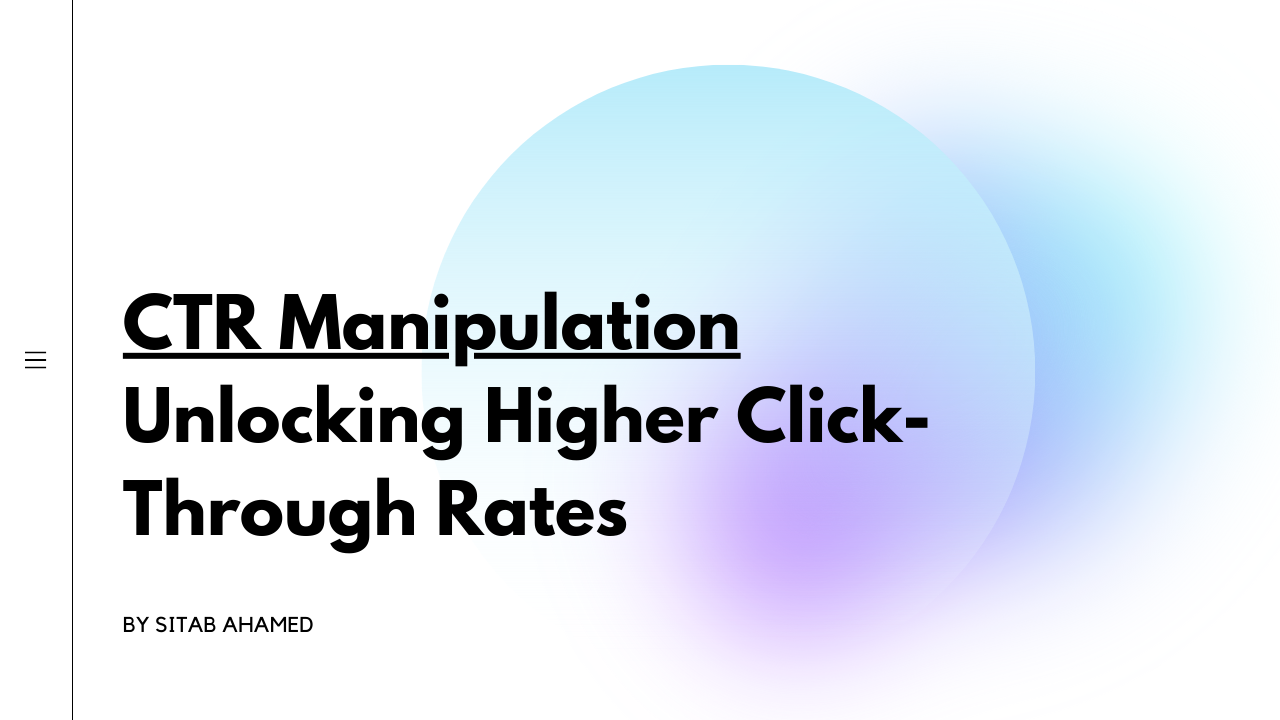CTR Manipulation Press Release-- Announcing New Techniques for CTR Optimization
Effective CTR Control: Increasing Your Web content's Reach
In the competitive landscape of electronic material, mastering the art of click-through price (CTR) adjustment is crucial for enhancing your reach and engagement. CTR Manipulation. By employing strategic methods such as crafting compelling headings, making use of attractive visuals, and optimizing calls to activity, web content creators can significantly boost their efficiency metrics.
Understanding Click-Through Price

Numerous variables influence CTR, consisting of the placement of the web link, the significance of the material, and the general user experience. Elements such as visuals, color design, and call-to-action (CTA) wording play significant duties in attracting individual focus. In addition, audience targeting can significantly influence CTR, as tailored messages resonate much more with details demographics.
Monitoring CTR over time enables marketing professionals to identify fads and make data-driven choices. A/B screening various techniques can aid determine which methods yield the greatest engagement. By evaluating CTR alongside various other metrics, such as conversion prices and customer habits, marketing professionals can fine-tune their strategies to optimize efficiency and improve the return on investment for their electronic marketing initiatives.
Crafting Engaging Headings
Crafting engaging headings is necessary for capturing audience interest and driving involvement. A well-written heading works as the very first factor of contact between your content and potential readers, making it important to invest time in its advancement. To attain this, think about using the principles of quality, importance, and seriousness.

Additionally, integrating aspects of necessity can significantly enhance the probability of clicks. Expressions such as "minimal time deal" or "do not lose out" can create a sense of immediacy that forces visitors to act quickly.
Finally, think about leveraging numbers or inquiries in your headings, as they have a tendency to record attention effectively. "5 Tips to Boost Your Productivity" or "Are You Making These Common Blunders?" can lure readers to engage with your material. By grasping the art of heading crafting, you can substantially enhance your content's reach and impact.
Utilizing Appealing Visuals
Captivating visuals can substantially enhance user involvement and enhance click-through rates. The human brain procedures pictures 60,000 times faster than text, making visuals an essential part in standing out. Premium images, infographics, and video clips not just draw the eye yet likewise convey intricate information effectively, resulting in better target these details market understanding and retention.
When choosing visuals, consider significance and quality. Photos need to line up with your material and resonate with your target market to develop a cohesive message. Additionally, using dynamic shades and dynamic make-ups can evoke psychological responses, additional encouraging users to involve with your content.
Integrating infographics can be particularly efficient, as they offer data and data in a conveniently absorbable style. This not just makes information a lot more accessible however also increases shareability throughout social systems. Videos, on the various other hand, can mesmerize customers and increase dwell time on your site, more signaling to internet search engine that your material is beneficial.
Optimizing Contact Us To Action
To drive customer engagement successfully, maximizing contact us to action (CTAs) is critical. CTAs serve as the critical bridge in between material intake and desired user habits, whether that be clicking with to an additional page, signing up for a newsletter, or buying. The quality and presence of CTAs significantly impact click-through rates.
First, take into consideration the positioning of CTAs; they ought to be purposefully positioned within the content to catch customers' interest without being invasive. Next off, the language used in CTAs should be engaging and action-oriented.
Furthermore, the layout of CTAs need to be aesthetically unique from surrounding content. Making use of contrasting shades and adequate white area can enhance exposure and charm. Furthermore, guarantee that CTAs are mobile-responsive, as a significant portion of customers engage with content on smart phones.
Ultimately, a well-optimized CTA can substantially affect individual engagement and boost the general efficiency of your material strategy.
Studying and Testing Strategies
Reliable analysis and testing methods are vital for making best use of the impact of CTAs and general individual that site involvement. By implementing robust analytics tools, marketing experts can collect critical data on individual interactions, recognizing which CTAs resonate most with target market. Trick browse around this site performance indicators (KPIs) such as click-through rates, conversion rates, and bounce rates ought to be kept track of regularly to examine CTA effectiveness.
A/B testing is a necessary approach for maximizing CTAs. By contrasting variants of a solitary CTA, marketing professionals can establish which style, wording, or positioning yields higher engagement. For instance, altering the color or dimension of a switch can dramatically affect user habits. Additionally, multivariate screening can give much deeper understandings by examining several variables at the same time.
Beyond testing, detailed analysis of customer demographics and behavior patterns can notify even more customized web content strategies. Ultimately, a systematic strategy to analysis and testing cultivates continuous enhancement, making certain CTAs develop together with changing user preferences and technical innovations.
Conclusion
Finally, reliable manipulation of click-through rates requires a diverse strategy that combines compelling headings, captivating visuals, and optimized telephone calls to activity. Through precise analysis and constant A/B screening, web content makers can improve these elements, thus improving individual interaction and increasing material reach. Inevitably, the critical assimilation of these parts is necessary for driving greater click-through prices and attaining better total web content efficiency in a significantly affordable electronic landscape.